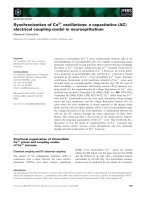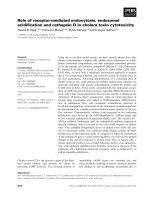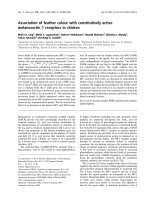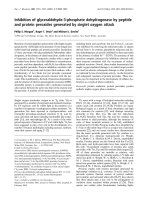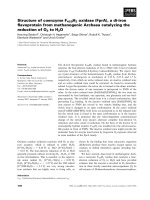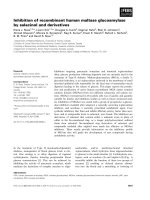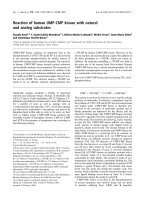Báo cáo khoa học: Re-evaluation of intramolecular long-range electron transfer between tyrosine and tryptophan in lysozymes Evidence for the participation of other residues doc
Bạn đang xem bản rút gọn của tài liệu. Xem và tải ngay bản đầy đủ của tài liệu tại đây (215.6 KB, 7 trang )
Re-evaluation of intramolecular long-range electron transfer between
tyrosine and tryptophan in lysozymes
Evidence for the participation of other residues
Marilyne Stuart-Audette
1
, Yves Blouquit
2
, Moshe Faraggi
3
,Ce
´
cile Sicard-Roselli
1
, Chantal Houe
´
e-Levin
1
and Pierre Jolle
`
s
4
1
LCP, Centre Universitaire, Orsay Cedex, France;
2
Institut Curie-Section de Recherche, Centre Universitaire, Orsay Cedex, France;
3
Department of Nuclear Engineering, Ben Gurion University of the Negev, Israel;
4
Laboratoire de Chimie, Muse
´
um National
d’Histoire Naturelle, and LNCP, Universite
´
Paris 6, France
One-electron oxidation of six different c-type lysozymes
from hen egg white, turkey egg white, human milk, horse
milk, camel stomach and tortoise was studied by gamma-
and pulse-radiolysis. In the first step, one tryptophan side
chain is oxidized to indolyl free radical, which is produced
quantitatively. As shown already, the indolyl radical subse-
quently oxidizes a tyrosine side chain to the phenoxy radical
in an intramolecular reaction. However this reaction is not
total and its stoichiometry depends on the protein. Rate
constants also vary between proteins, from 120Æs
)1
to
1000Æs
)1
at pH 7.0 and room temperature [extremes are hen
and turkey egg white (120Æs
)1
) and human milk (1000Æs
)1
)].
In hen and turkey egg white lysozymes we show that another
reactive site is the Asn103–Gly104 peptidic bond, which gets
broken radiolytically. Tryptic digestion followed by HPLC
separation and identification of the peptides was performed
for nonirradiated and irradiated hen lysozyme. Fluorescence
spectra of the peptides indicate that Trp108 and/or 111
remain oxidized and that Tyr20 and 53 give bityrosine.
Tyr23 appears not to be involved in the process. Thus new
features of long-range intramolecular electron transfer in
proteins appear: it is only partial and other groups are
involved which are silent in pulse radiolysis.
Keywords: gamma and pulse radiolysis; intramolecular long-
range electron transfer; lysozyme; one-electron oxidation.
The early suggestions [1,2] of intramolecular long-range
electron transfer (LRET) have now been verified by numer-
ous observations of LRET between donor/acceptor redox
centres with known separation distances in proteins, peptides
and other small rigid organic molecules. This property exists
in polymers and especially in biopolymers (proteins and
DNA). Thus these macromolecules are considered as
candidates for nanoelectronics components. In this view,
several studies were devoted to a better understanding of the
factors leading to modulation of LRET (for a review, see [3]
and references therein [4–6]). As part of a program to unravel
the mechanistic basis of LRET in proteins, systematic
investigations on electron transfer between tyrosine and
tryptophan in proteins and peptides have been conducted
[7–10]. In this experimental system, developed first by Pru
¨
tz
et al. [11], pulse radiolytically generated azide radical and
dibromide radical anion preferentially oxidize the side chain
of tryptophan (Trp) to the indolyl radical (Trp
Æ
) in molecules
that also contain tyrosine (Tyr).
N
Æ
3
þ Trp-X-Tyr ! Trp
Æ
-X-Tyr+N
À
3
þ H
þ
ð1Þ
The initiating oxidation (1) can be effected by other
radiolytically generated species such as the dibromide
(Br
2
–
) and dichloride (Cl
2
–
) radical anions [12]. The trypto-
phan neutral radical, with a midpoint reduction potential
that is near 1 V at pH 7.0 [13], rapidly oxidizes the tyrosine
side chain to the phenoxy radical (TyrO
Æ
)intheintra-
molecular equilibration:
Trp
Æ
-X-Tyr $ Trp-X-TyrO
Æ
ð2Þ
Both TyrO
Æ
and Trp
Æ
absorb strongly in different parts of the
visible region. One of the first observations of reaction (2) in
proteins was obtained in hen egg white lysozyme (HEWL)
[14–16].
However previous pulse radiolysis studies indicated a low
yield of tyrosyl radical compared to that of initial oxidant
and of tryptophanyl radical [14]. Since the final products
coming from this process were never characterized, the
stoichiometry of LRET was never evaluated. The aim of
the experiments described in this paper was thus to verify
whether the stoichiometry in LRET (equality of tyrosyl vs.
tryptophanyl radicals) was respected, to identify some of the
aromatic amino acids responsible of LRET, and possible
other processes involved.
Correspondence to C. Houe
´
e-Levin, LCP, UMR 8000 baˆ t. 350,
Centre Universitaire, 91405 Orsay Cedex, France.
Fax:+33169153053,Tel.:+33169155549,
E-mail: ,
Web site:
Abbreviations: HEWL, hen egg white lysozyme; TEWL, turkey egg
white lysozyme; Trp
Æ
, the indolyl radical of tryptophan; TrpH
Æ+
,the
protonated indolyl radical of tryptophan; TyrO
Æ
, the phenoxy radical
of tyrosine; LRET, long-range electron transfer.
(Received 7 April 2003, revised 6 June 2003, accepted 7 July 2003)
Eur. J. Biochem. 270, 3565–3571 (2003) Ó FEBS 2003 doi:10.1046/j.1432-1033.2003.03741.x
The c-type lysozymes (129–130 amino acids in most
cases) having similar sequences (for the sequences see [17]),
three-dimensional structures (obtained by crystallography
and two-dimensional NMR in solution) and biochemical
activity [18–22] provide an excellent model system for
exploring the effect of amino acid substitution on the
intramolecular electron transfer.
This approach complements other studies, directed at
understanding the electron transfer process, which involves
changing the protein sequence by site-directed mutagenesis
and the use of chemically modified proteins. However in this
work we show that another process i.e. a peptide bond
fragmentation, is initiated by LRET, which means that
there might be some ÔleakageÕ in electron transfer. These
points are crucial for understanding of redox processes
in biology and also for an eventual development of nano-
electronics.
Experimental procedures
Chemicals (sodium azide, potassium phosphate, sodium
hydroxide) were of the highest quality available (Prolabo
Normatom or Merck Suprapure). Nitrous oxide was
delivered by ALPHA GAZ; its purity was higher than
99.99%. HEWL, EC 3.2.1.17 (crystallized three times,
dialyzed and lyophilized), and turkey egg white lysozyme
(TEWL) were supplied by Sigma. Other lysozymes were
prepared using known procedures [23]. The purity of the
protein preparations was tested by SDS/PAGE according
to Sha
¨
gger and von Jagow [24] and by reversed-phase
HPLC. All proteins were used after dialysis against buffer.
The solution concentration was verified by the protein
absorbance at 278 nm [25]. Water was obtained from an
Elga Maxima device (resistivity ¼ 18.2 MX).
In gamma radiolysis, protein solutions (1.4 · 10
)4
M
)in
10 m
M
potassium phosphate buffer (pH 7.0) and 0.1
M
sodium azide (NaN
3
) in order to produce the azide radical,
were saturated with N
2
O. Protein solutions were prepared
shortly prior to irradiation. The samples were submitted to c
irradiation in a panoramic IL60PL (Cis Bio International)
60
Co source at a dose rate, determined by Fricke dosimeter,
of approximately 1.0 GyÆs
)1
.
For pulse radiolysis, radicals were generated by the
introduction into an aqueous solution of a 200-ns pulse of
high-energy electrons (% 4 MeV) from a linear accelerator
located at the Curie Institute, Orsay France [26].
In both cases, the predominant primary radical products,
e
aq
–
and OH
Æ
, formed by ionizing particle (high energy
electrons or photons) interactions with water [27], were
converted to the azide radical, N
3
, by reactions with N
2
O
at saturation and 0.1 molÆL
)1
azide anion [27]. The pH of
the solution was adjusted with 5–20 mmolÆL
)1
phosphate
buffer. In order to prevent foam formation (denaturation of
the protein) saturation with N
2
O was carried out by
introducing the gas on top of the stirred cold (4 °C)
solution for 60 min. The total radical concentration was
% 2 lmolÆL
)1
determined by methyl viologen dosimetry
[28]. These low concentrations were used to minimize
possible second-order decays of TyrO
Æ
and Trp
Æ
. The protein
was present at 0.14 mmolÆL
)1
(2 mgÆmL
)1
), except when we
determined the concentration dependence of the rate
constant for reaction (1). For this experiment the protein
concentration was varied between 0.05 and 0.5 mmolÆL
)1
.
All reactions, monitored by changes in the UV–visible
region, were functionally first order, and the rate constants
were obtained by nonlinear least-squares fitting to the
absorbance data. The numbering of the amino acid residues
in each lysozyme protein follows that of the Protein Data
Bank (PDB) of the Brookhaven National Laboratories.
Irradiated protein solutions were analysed by SDS/
PAGE and by HPLC. b-mercaptoethanol was added to
the irradiated samples to reduce the disulphide bridges
before electrophoretic analysis on a SDS-containing gel.
Proteins bands were stained with Coomassie blue R-250.
Stained gels were scanned using an Ultrascan XL laser
microdensitometer (LKB). The proportion of material
present in each band was determined using the intensity of
the vertical cut corrected for the bandwidth.
Dimers were separated from the monomers by HPLC,
using a PorosR1 (4 · 100 mm) column. A gradient of
35–60% (trifluoroacetic acid 0.1%/acetonitrile 70%) in
trifluoroacetic acid over 30 min (at a flow rate of 1.5
mLÆmin
)1
) was used. Detection was at 214 nm.
Evaluation of the fraction of dimerized proteins was
achieved by calculation of the portion of the total area
under the curve occupied by the dimers peak. The obtained
value was divided by two.
MALDI-TOF MS was performed at The Institute of
Nuclear Physics, Orsay, France. N-terminal sequencing was
done at IBCP, Lyon, France.
For aminoethylation, proteins were kept 2 h in a solution
containing 6
M
urea, 1
M
Tris pH 8.6, 10 m
M
EDTA;
b-mercaptoethanol (50 m
M
) was added to reduce the
disulfide bridges. Ethylene imine (Fluka) was added (20
times expected thiol concentration) and the solution was
incubated in the dark for 40 min before 20 lLÆmL
)1
of
2-mercaptoethanol was added. Salts were removed using
reversed-phase HPLC and the samples were dried using a
Speed-vac Savant apparatus.
Trypsin hydrolysis was performed in ammonium hydro-
genocarbonate (100 mgÆmL
)1
) aqueous solution. Protein
concentration was 2 mgÆmL
)1
, 3% w/w of trypsin (Worth-
ington) was added. The solution was kept overnight at
30 °C. Peptides were separated on a column Vydac C4
(4.6 · 250 mm). Solution A was a solution of trifluoroacetic
acid (0.1%), solution B was a solution of 0.1% trifluoro-
acetic acid and 70% acetonitrile (gradient 0–100% B in
90 min, flow rate 1 mLÆmin
)1
). Detection was at 214 nm.
Gel permeation chromatography was performed at 5 °C
with buffer 0.2
M
Na
2
SO
4
,0.1
M
phosphate pH 6.5, sapo-
nine 0.005%. Precipitation of proteins was first achieved
with ammonium sulphate. The column (3 · 50 · 90 cm)
was filled with gel TSK Toyopearl (HW40S or HW50S) or
Ultrogel ACA50.
Results
Pulse radiolysis
Pulse radiolysis studies of amino acids and peptides have
shown that below pH 9.0 the tryptophan side chains,
compared with other amino acid residues, react rapidly with
the azide radical so that one-electron indole oxidation is the
predominant reaction in peptides and proteins containing
3566 M. Stuart-Audette et al. (Eur. J. Biochem. 270) Ó FEBS 2003
both tryptophan(s) and tyrosine(s) [7–14]. This initial, rapid
increase of absorbance between 350 nm and 600 nm with a
maximum at 510 nm is due to Trp formation (Fig. 1). From
the linear dependence of the pseudo-first order rate
constants on protein concentration an average second-order
rate constant of (9.5 ± 0.9) · 10
8
LÆmol
)1
Æs
)1
(25 °C) for
TEWL was calculated. Similar second-order rate constants
were obtained for the other lysozymes (Table 1).
This initial, rapid increase of absorbance is followed by a
slower decrease of the 510 nm band due to Trp
Æ
reduction.
This Trp
Æ
reduction is accompanied by tyrosine oxidation to
TyrO
Æ
, seen from the simultaneous absorbance increase at
410 nm (Fig. 1). The time-dependent spectral changes
during this one-electron transfer from tyrosine to Trp
Æ
resemble the changes obtained with peptides containing
both tryptophan and tyrosine; i.e. absorbance maxima at
% 510 and 410 nm, and isosbestic points at % 430 nm and
% 370 nm [7,8]. These isosbestic points, together with the
fact that the apparent first-order reaction rate constant is the
same whether measured at 410 or 510 nm, suggest that
electron transfer from tyrosine to Trp
Æ
occurs in a single
step. It was also established that this transfer is in fact first
order by demonstrating that the apparent rate constant is
independent of protein concentration from 5 · 10
)5
to
5 · 10
)4
molÆL
)1
. Thus, electron transfer between a tyro-
sine residue and a tryptophanyl radical in all the lysozymes
studied appears to be an intramolecular process. The
monomolecular rate constants at pH 7.0 and 25 °Care
summarized in Table 1. In the seconds time range there is a
final slow radical decay. This reaction was always second-
order representing a radical–radical recombination reaction
(e.g. dimerization of TyrO
Æ
radical). Thus, the reaction (2)
equilibrium is reached before appreciable radical loss occurs
via a slow decay [under the condition of our experiments the
slowest intramolecular electron transfer half-life for HEWL
and TEWL was 5 ms at pH 7.0). The determination of the
intramolecular first-order rate constant is not compromised
by a reaction overlap with radical decay.
We can estimate the Trp
Æ
and TyrO
Æ
yields in the lysozymes
from the magnitudes of the absorbance changes at 510 and
410 nm and the assumption that the extinction coefficients
of the protein bound radicals and those measured from
amino acids peptides are the same: for Trp
Æ
, these are 1800
and 300 LÆmol
)1
cm
)1
at 510 and 410 nm, respectively; for
TyrO
Æ
, 70 and 2600 LÆmol
)1
Æcm
)1
at, respectively, 510 and
410 nm [29,30]. The estimated Trp
Æ
yields calculated for
the initial oxidation of the proteins above pH 4.5 by the
inorganic radicals were quantitative. The estimated overall
TyrO
Æ
yields after reaction (2) varied with the protein and
could be as low as 40% compared to the 90% loss of Trp
after the completion of this reaction. We confirm that the
process is nonstoichiometric and that the amount of LRET
depends on the primary structure of the protein.
Final products
The final products were detected and quantified after pulse
and steady-state gamma radiolysis, by SDS/PAGE and by
HPLC (typical electrophoresis gels are shown on Fig. 2).
Localization of dimers
For all lysozymes studied, dimers are found and their
quantity increases with the dose. The G-values of dimeri-
zation measured by HPLC or by SDS/PAGE do not
depend much on the origin of the protein [31].
The presence of bityrosine could be detected by absorp-
tion [32] and fluorescence, with an excitation wavelength of
325 nm; its emission signal is centred at 410 nm. Using gel
permeation liquid chromatography, lysozyme dimers were
partially separated from the monomers. It was observed
that the fluorescence signal for bityrosine comigrates with
the fractions containing the dimerized proteins.
Fig. 1. Pulse radiolysis study of TEWL oxidation by azide radicals.
Protein 1.4 · 10
)4
ÆmolÆL
)1
, phosphate buffer 10 m
M
pH 7.0, [N
3
–
] ¼
10
)2
ÆmolÆL
)1
,N
2
O atmosphere (% 1 atm), dose 4 Gy. Optical path
2cm.
Table 1. Rate constants of LRET, number and location of Tyr and Trp residues, for the various lysozymes.
Lysozyme source
(No. of amino acids)
Number of Trp/
molecule (position)
Number of Tyr/
molecule (position) k
Lys+N3
mol
)1
Ædm
3
Æs
)1
k
LRET
s
)1
Hen egg white (129) 6 (28, 62, 63, 108, 111, 123) 3 (20, 23, 53) (7.9 ± 0.8) · 10
8
120 ± 10
Turkey egg white (129) 6 (28, 62, 63, 108, 111, 123) 4 (3, 20, 23, 53) (9.5 ± 0.9) · 10
8
120 ± 10
Horse milk (129) 5 (28, 62, 63, 108, 111) 4 (23, 34, 54, 123) (7.0 ± 0.7) · 10
8
230 ± 20
Camel stomach (130) 6 (3, 28, 34, 64, 109, 112) 6 (20, 38, 45, 54, 63, 124) (6.3 ± 0.7) · 10
8
500 ± 50
Tortoise (130) 5 (28, 64, 109, 112, 124) 6 (3, 20, 23, 45, 54, 63) (7.8 ± 0.8) · 10
8
300 ± 30
Human milk 5 (28, 34, 64, 109, 112) 6 (20, 38, 45, 54, 63, 124) (4.7 ± 1.0) · 10
8
1000 ± 100
Ó FEBS 2003 Pulse radiolysis oxidation of c-type lysozymes (Eur. J. Biochem. 270) 3567
The fractions containing the HEWL dimers and samples
of irradiated solutions were hydrolysed by trypsin and amino
groups were ethylated. Then fragments were separated by
HPLC and identified by their amino acid sequences. The
relative population of the peptide fractions from the
irradiated samples were compared to the corresponding
ones obtained with the native lysozyme. The proportions of
tyrosine 23- and 53-containing fractions were found to be
significantly lower in the dimer-rich preparations. (Fig. 3). A
fraction of each peptide was analysed by fluorescence, a very
sensitive technique. The bityrosine signal was observed in all
peptides containing tyrosine 23 or 53 but not in peptides
containing tyrosine 20 alone. According to these results,
tyrosines 23 and 53 could be involved in the dimerizations
whereas no sign of tyrosine 20 involvement was seen.
Oxidized tryptophans
An increase in 315 nm absorbance was also observed in
nondimerized fractions demonstrating that at least another
oxidation product was formed. Tryptophan solutions,
irradiated in the presence of N
3
, also show a dose-dependent
increase in 315 nm absorbance (M. Stuart-Audette,
C. Sicard-Roselli, C. Houe
´
e-Levin, unpublished results).
Knowing that the electron transfer between Trp and Tyr is
partial, we have been seeking for tryptophan oxidation
products. Further fluorescence studies shown the presence
of a different emission spectrum upon excitation at 380 nm.
The signal is compatible with the presence of N-formyl-
kynurenine [33].
The peptides obtained by hydrolysis of irradiated solu-
tion, for which the amino acid composition of peptides
was determined, were screened for the fluorescence signal
obtained when an excitation wavelength of 380 nm is used.
The signal was observed in peptides containing tryptophans
108 and 111. Because none of the peptide contains only
tryptophan 108 or 111, it was not possible to identify which
of the two (if not both) is oxidized and not repaired. The
relative proportions of the irradiated fractions, at different
doses, were compared to the ones obtained with the native
HEWL. Tryptophan 108- and 111-containing peptides
decreased rapidly as doses were increased. No indication
of tryptophan 28, 62, 63 and 123 modifications was noted.
Fragments
In addition to dimerization, HEWL and TEWL appear to
undergo fragmentation. The N-terminal sequences of the
first 10 amino acids of the longest moieties are identical to
that of the native proteins. MS of HEWL gave a small peak
corresponding to 11 286 Da and another one corresponding
to 3047.5 Da (Fig. 4). For TEWL, we find 3055.7 Da for the
smaller moiety. This allows us to determine the site of
fragmentation at the peptidic bond between Asn103 and
Gly104 for both proteins. In addition, N-terminal sequen-
cing of the smaller moiety indicated that Gly residue is intact.
It is interesting to note that TEWL, which has the same
Asn103–Gly104 sequence, gets also fragmented at the same
site as HEWL, whereas human milk lysozyme and tortoise
lysozyme, which do not get fragmented upon oxidation, do
not have the Asn103–Gly104 sequence (Fig. 2). The yields of
fragmentation (Table 2) vary for these proteins.
Discussion
In this work, we performed a comparative study of the one-
electron oxidation of six proteins from the c-type family of
lysozymes; these proteins differ by several amino acids but
their three-dimensional structures are very similar.
Pulse radiolysis results show that the rate constants of
one-electron oxidation by azide radicals are of the same
order of magnitude. For all proteins, tryptophanyl radicals
Fig. 2. SDS/PAGE analysis in reducing con-
ditions of irradiated lysozymes. (A) Hen egg
white, (B) turkey egg white, (C) tortoise egg
white, (D) human milk lysozymes. D, Dimer;
L,lyoszyme;F,fragment.
3568 M. Stuart-Audette et al. (Eur. J. Biochem. 270) Ó FEBS 2003
are obtained first, and the stoichiometry N
3
Æ
/Trp
Æ
is
observed. This oxidation is always followed by a reaction,
in which Trp
Æ
disappears and TyrO
Æ
is formed. The limiting
step is intramolecular, as it was already shown for peptides
and proteins. The rate constants differ by a factor of % 8
with the protein (Table 1).
For all proteins the LRET is not stoichiometric. In
addition the TyrO
Æ
yield varies with the protein. These
apparently low TyrO
Æ
yields could be due to side reactions in
which Trp
Æ
is lost by some other path. Although Trp
Æ
is a
relatively good oxidant because of its reduction potential,
there has been no report of Trp
Æ
oxidizing any amino acid
other than tyrosine. For example, one could suggest that the
disulfide bond could be the electron donor to the indolyl
tryptophan radical. However, the reduction potential of
the couples TrpH
+Æ
/Trp (pH < 4.5) and Trp
Æ
/Trp (neutral
pH) are, respectively, 1.15 V and 1.05 V [13], whereas that of
the RSSR
+Æ
/RSSR is % 1.3 V (D. Armstrong, University of
Calgary, Canada, personal communication). This difference
in reduction potentials makes the oxidation of a disulfide
bond by the indolyl radical (protonated or unprotonated)
highly improbable. Nevertheless, we have studied this
reaction by observing the decay of the indolyl radical in the
presence and absence of the disulfide model compound
(lipoate anion) and found no effect (data not shown).
For the first time in this kind of study, we tried to
determine the nature of the final products in HEWL and
TEWL. We were expecting mostly dimers, since it is known
that the fate of tyrosyl radicals is dimerization. Surprisingly,
we found in addition to dimers, oxidized forms (without
great change of the molecular mass) and fragments. The site
of fragmentation is the peptide bond between Asn103 and
Gly104. The fragmentation is highly sequence specific: if
Asn–Gly sequence is not present, the protein is not cleaved.
The N-terminal amino acid of the shorter fragment could be
detected by sequencing, showing that the amino group is
intact. Since no hydrolysis is observed without radiolytic
oxidation, the fragmentation process appears to be linked to
the oxidation. To our knowledge, for the first time, the
participation of residues other than aromatic in oxidative
processes is demonstrated. Tryptophanyl radicals might
reduce the peptide bond which would then undergo
fragmentation, in agreement with [34]. Indeed, we found
that Trp108 and/or Trp111, which are the closest to the
Asn103–Gly104 sequence, are oxidized. We have investi-
gated the possibilities of creation of a free radical site,
positive or negative, in this sequence by methods of
quantum chemistry [35]. The aim was to see if any of this
Fig. 4. MALDI-TOF mass spectra of fragments from irradiated lyso-
zymes. Lysozymes were reduced by 2-mercaptoethanol and fragments
were isolated by HPLC. (A) Hen egg white, (B) turkey egg white
lysozymes.
Fig. 3. Separation of tryptic fragments of HEWL after aminoethyla-
tion. Detection at 214 nm *New fragments formed by irradiation.
Nonirradiated; irradiated (100 Gy).
Table 2. Yields (G-values) of polypeptide chain fragmentation for hen,
turkey and tortoise lysozymes.
Lysozyme
Fragmentation
yield (molÆJ
)1
)
Percent of azide radicals
(yield 5.5 · 10
)7
ÆmolÆJ
)1
)
Hen (1.42 ± 0.03) · 10
)8
2.5
Turkey (0.68 ± 0.03) · 10
)8
1.2
Tortoise 0.0 0
Ó FEBS 2003 Pulse radiolysis oxidation of c-type lysozymes (Eur. J. Biochem. 270) 3569
free radical would lead to peptide bond elongation, a
prerequisite for bond breakage. Such a modification was
found for the radical anion. This would be in agreement
with intramolecular reduction of this sequence.
Attempts to identify the position of oxidized residues
were performed with HEWL. Tryptic hydrolysis followed
by identification of the fragments and fluorescence detec-
tion, indicated that: (a) Tyr53 and Tyr23 are oxidized; (b)
Trp108 and/or Trp111 are oxidized. Typ53 is very close to
Trp62 and Trp63. Bobrowski et al. [36] have shown that
residues of HEWL Trp62 are part of the initial process
yielding % 50% of the observed LRET. They proposed that
these radical residues are reduced by Tyr53, and our results
are in agreement with this hypothesis. Based on the first-
order rate constants measured in the model peptide
compounds with oligoprolines as spacers and using these
results as a ruler for the proteins, the value of 120 s
)1
found
for HEWL and TEWL suggests a separation distance
between donor and acceptor of % 1.4 nm [7,8,10] and thus a
similar pattern of oxidation. Indeed, the similarity of NOE
data, hydrogen-exchange rates, chemical shifts and coupling
constants of the two proteins are indicative that structures
of HEWL and TEWL are essentially identical [37]. It should
be noted that the presence of Tyr at position 3 did not affect
the rate constant suggesting that this residue does not
participate in the intramolecular process. Nevertheless,
dimerization of Tyr23 could come also from Trp62 and/or
Trp63. However Trp108 and Trp111 are at a closer distance
and since they remain oxidized, we conclude that no
intramolecular electron transfer was initiated from these
residues. It seems that the argument of distance is not
sufficiently explanatory.
In conclusion, the long-range intramolecular electron
transfer process appears to be much more complicated than
was previously thought. Some tryptophan residues do not
lead to LRET and no explanation comes from examination
of the distances. Some tyrosine residues (such as Tyr20 and
Tyr3 in TEWL) are not involved in the process and similarly
the argument of distances does not provide explanations. In
addition, an unexpected fragmentation site is observed: the
Asn103–Gly104 sequence. More careful investigations of
LRET are needed, including analysis of the final com-
pounds, to reach an understanding of the process.
Acknowledgements
M.F. thanks the Curie Institute, the Yvette Mayent award and Dr
D. Lavalette, director of the INSERM unit 350 for his hospitality. We
are indebted to the Curie Institute and especially to Dr V. Favaudon for
the use and maintenance of the linear accelerator and for fruitful
discussions.
References
1. Grossweiner, L.I. (1976) Photochemical inactivation of enzymes.
Curr. Top. Radiat. Res. Q. 11, 141–199.
2. Klapper, M.H. & Faraggi, M. (1979) Applications of pulse radio-
lysis to protein chemistry. Q. Rev. Biophys. 12, 465–519.
3. Houe
´
e-Levin, C. & Sicard-Roselli, C. (2001) Radiation chemistry
of proteins. In Radiation Chemistry: Present Status and Future
Prospects (Jonah, C. & Rao, B.M., eds), pp. 553–584. Elsevier,
New York.
4. Feng,C.,Kedia,R.V.,Hazzard,J.T.,Hurley,J.K.,Tollin,G.&
Enemark, J.H. (2002) Effect of solution viscosity on intra-
molecular electron transfer in sulfite oxidase. Biochemistry 41,
5816–5821.
5. Filipe, P., Morliere, P., Patterson, L.K., Hug, G.L., Maziere, J C.,
Maziere,C.,Freitas,J.P.,Fernandes,A.&Santus,R.(2002)
Repair of amino acid radicals of apolipoprotein B100 of low-
density lipoproteins by flavonoids. A pulse radiolysis study with
quercetin and rutin. Biochemistry 41, 11057–11064.
6. Feng, C., Wilson, H.L., Hurley, J.T., Hazzard, J.K., Tollin, G.,
Rajakopalan, K.V. & Enemark, J.H. (2003) Role of conserved
tyrosine 343 in intramolecular electron transfer in human sulfite
oxidase. J. Biol. Chem. 278, 2913–2920.
7. Faraggi, M., DeFelippis, M.R. & Klapper, M.H. (1989) Long-
range electron transfer between tyrosine and tryptophan in pep-
tides. J. Am. Chem. Soc. 111, 5141–5145.
8. DeFelippis, M.R., Faraggi, M. & Klapper, M.H. (1990) Evidence
for through-bond long range electron transfer in peptides. J. Am.
Chem. Soc. 112, 5640–5642.
9. Lee, H., Faraggi, M. & Klapper, M.H. (1992) Long range
electron transfer along an alpha-helix. Biochim. Biophys. Acta
1159, 286–294.
10. Bobrowski, K., Wierzchowski, K.L., Holcman, J. & Ciurak, M.
(1990) Intramolecular electron transfer in peptides containing
methionine, tryptophan and tyrosine: a pulse radiolysis study.
Int. J. Radiat. Biol. 57, 919–932.
11. Pru
¨
tz, W.A., Butler, J., Land, E.J. & Swallow, A.J. (1980) Direct
demonstration of electron transfer between tryptophan and tyro-
sine in proteins. Biochem. Biophys. Res. Commun. 96, 513–520.
12. Adams, G.E., Wilson, R.L., Aldrich, J.E. & Cundall, R.B. (1969)
On the mechanism of the radiation-induced inactivation of lyso-
zyme in dilute aqueous solution. Int. J. Radiat. Biol. Relat. Stud.
Phys. Chem. Med. 16, 333–342.
13. DeFelippis, M.R., Murthy, C.P., Faraggi, M. & Klapper, M.H.
(1989) Pulse radiolytic measurement of redox potentials: the tyro-
sine and tryptophan radicals. Biochemistry 8, 4847–4853.
14. Butler, J., Land, E.J., Prutz, W.A. & Swallow, A.J. (1982) Charge
transfer between tryptophan and tyrosine in proteins. Biochim.
Biophys. Acta 705, 150–162.
15. Weinstein, M., Alfassi, Z.B., DeFelippis, M.R., Klapper, M.H. &
Faraggi, M. (1991) Long range electron transfer between tyrosine
and tryptophan in hen egg-white lysozyme. Biochim. Biophys. Acta
1076, 173–178.
16. Bobrowski, K., Holcman, J. & Wierzchowski, K.L. (1989)
Temperature dependence of intramolecular electron transfer as a
probe for predenaturational changes in lysozyme. Free Rad. Res.
Commun. 6, 235–241.
17. Prager, E.M. & Jolle
`
s, P. (1996) Animal lysozymes c and g: an
overview. In Lysozymes: Model Enzymes in Biochemistry and
Biology (Jolle
`
s, P. ed.), pp. 9–31. Birkhauser-Verlag, Basel.
18. Smith, L.J., Sutcliffe, M.J., Redfield, C. & Dobson, C.M.
(1993) Structure of hen lysozyme in solution. J. Mol. Biol. 229,
930–944.
19. Howell, P.L., Almo, S.C., Parsons, M., Petsko, G.A. & Hajdu, J.
(1991) Structure determination of turkey egg-white lysozyme using
Laue diffraction data. Acta Crystallogr. Sect. B Struct. Sci. 48,
200–207.
20. Artymiuk, P.J. & Blake, C.C.P. (1981) Refinement of human
lysozyme at 1.5 A resolution analysis of non-bonded and
hydrogen-bond interactions. J. Mol. Biol. 152, 737–762.
21. Redfield, C. & Dobson, C.M. (1990)
1
H NMR studies of human
lysozyme: spectral assignment and comparison with hen lysozyme.
Biochemistry 29, 7201–7214.
22. Acharya, K.R., Stuart, D.I., Phillips, D.C., McKenzie, H.A. &
Teahan, C.G. (1994) Models of the three-dimensional structures of
3570 M. Stuart-Audette et al. (Eur. J. Biochem. 270) Ó FEBS 2003
echidna, horse, and pigeon lysozymes: calcium-binding lysozymes
and their relationship with alpha-lactalbumins. J. Protein Chem.
13, 569–584.
23. Jolle
`
s, P. & Jolle
`
s, J. (1984) What’s new in lysozyme research?
Mol. Cell Biochem. 63, 165–189.
24. Schagger, H. & von Jagow, G. (1987) Tricine-sodium dodecyl
sulfate-polyacrylamide gel electrophoresis for the separation of
proteins in the range from 1 to 100 kDa. Anal. Biochem. 166,368–
379.
25. Gill, J.C. & von Hippel, P.H. (1989) Calculation of protein
extinction coefficients from amino acid sequence data. Anal. Bio-
chem. 182, 319–326.
26. Favaudon, V., Tourbez, H., Houe
´
e-Levin, C. & Lhoste, J M.
(1990) CO2
.–
radical induced cleavage of disulfide bonds in pro-
teins. A gamma-ray and pulse radiolysis mechanistic investigation.
Biochemistry 29, 10978–10989.
27. Farhataziz, Rodgers, M.A.J. (1987) Radiation Chemistry. Princi-
ples and Applications. VCH, Weinheim.
28. Spinks, J.W.T. & Woods, R.J. (1990) Introduction to Radiation
Chemistry, 3rd edn. Wiley, New York.
29. Bensasson, R.V., Land, E.J. & Truscott, T.G. (1983) Flash
Photolysis and Pulse Radiolysis. Pergamon Press, Oxford.
30. Dudley, F.D., Santus, R. & Grossweiner, L.I. (1975) Laser flash
photolysis of aqueous tryptophan. J. Phys. Chem. 79, 2711–2716.
31. Audette, M., Blouquit, Y. & Houe
´
e-Levin, C. (2000) Oxidative
dimerization of proteins: role of tyrosine accessibility. Arch.
Biochem. Biophys. 76, 673–681.
32. Malencik, Q.A., Sprouse, J.F., Swanson, C.A. & Anderson, S.R.
(1996) Dityrosine: preparation, isolation, and analysis. Anal.
Biochem. 242, 202–213.
33. Van Wickern, B., Simat, T. & Steinhart, H. (1997) HPLC analysis
of c-irradiation-induced products of tryptophan in peptides and
lysozyme. Z. Lebensm. Unters Forsch. A. 205, 446–451.
34. Garrison, W.M. (1987) Reaction mechanisms in the radiolysis of
peptides, polypeptides, and proteins. Chem. Rev. 87, 381–398.
35. Houe
´
e-Levin, C. & Berge
`
s, J. (2002) A DFT study of electron and
hole localisation in a peptide containing asparagin. Eur. Phy. J. D
20, 551–555.
36. Bobrowski, K., Holcman, J., Poznanski, J. & Wierzchowski, K.L.
(1997) Pulse radiolysis studies of intramolecular electron transfer
in model peptides and proteins. 7. Trp fi TyrO radical transfor-
mation in hen egg-white lysozyme. Effects of pH, temperature,
Trp62 oxidation and inhibitor binding. Biophys. Chem. 63,
153–166.
37. Bartik,K.,Dobson,C.M.&Redfield,C.(1993)
1
H-NMR analysis
of turkey egg-white lysozyme and comparison with hen egg-white
lysozyme. Eur. J. Biochem. 215, 255–266.
Ó FEBS 2003 Pulse radiolysis oxidation of c-type lysozymes (Eur. J. Biochem. 270) 3571
